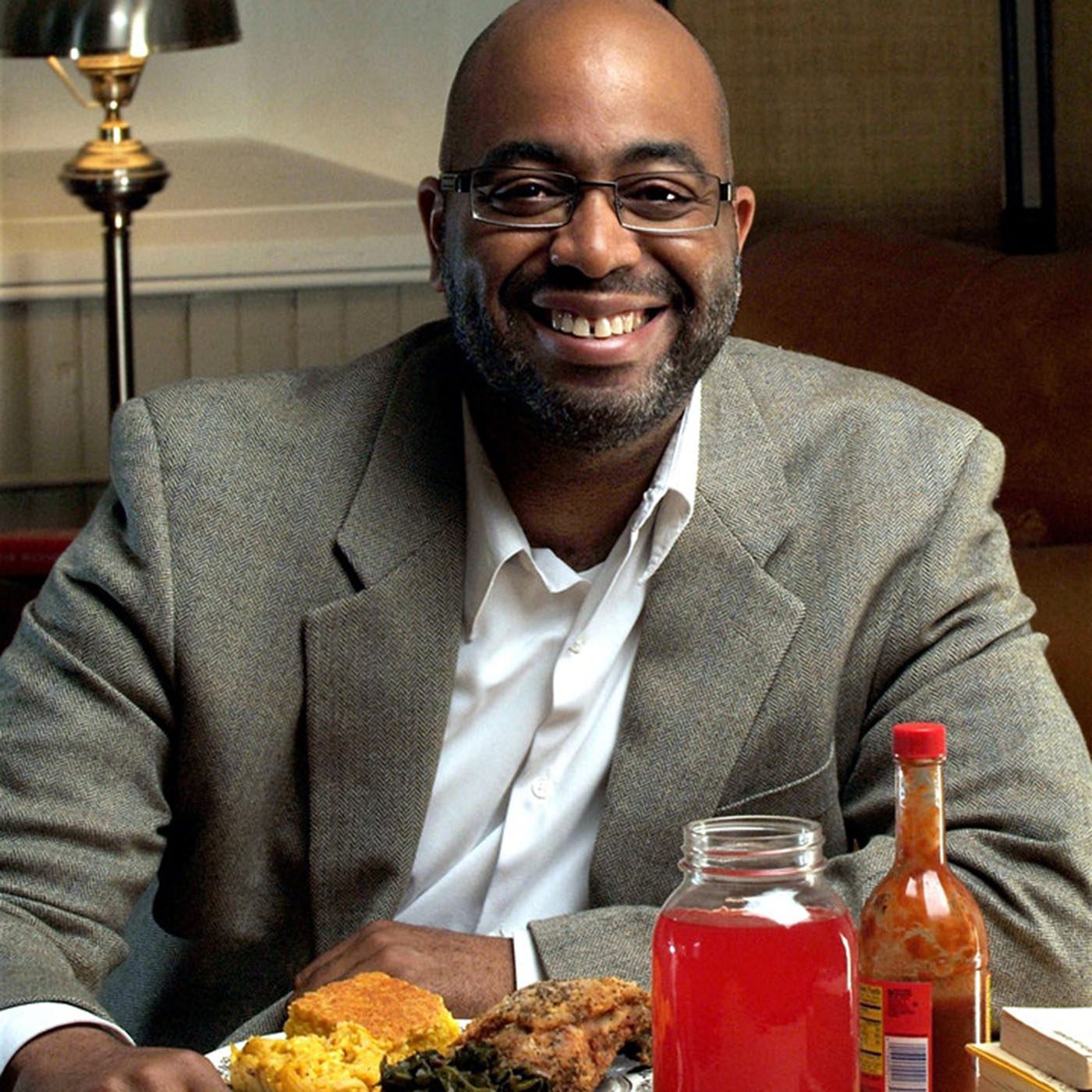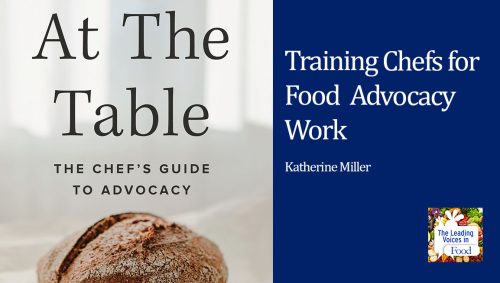The Leading Voices in Food
E104: Adrian Miller on the History of Soul Food
Two commonly known words “soul” and “food” capture so much meaning. There are the foods themselves–wonderfully diverse and prepared in homes, churches and restaurants–but there’s so much more to this. There’s a history, a culture, religion and the blending of cuisines from surprising places according to culinary historian Adrian Miller.
Subscribe: Apple Podcasts | TuneIN | Google Podcasts | SoundCloud | PocketCasts | Radio Public
Tags: Chefs & Food Writers | History & Food |

Adrian Miller is an attorney, a culinary historian and a certified barbecue judge who has lectured around the country on topics such as black chefs in the white house, chicken and waffles, hot sauce kosher soul food, red drinks, soda pop and of course, soul food. His book, “Soul Food: the surprising story of an American cuisine one plate at a time,” won the 2014 James Beard Foundation Book Award for Reference and Scholarship. He’s also been involved with public policy having served as a special assistant to President Clinton among other positions.
Interview Summary
Let’s start with this question: what is soul food?
I believe that soul food is actually the immigrant cuisine of African-American migrants who left the South during the great migration and settled in other parts of the country. A lot of people think of soul food as shorthand for all African-American cooking but I just think it’s just one aspect of it. Just a quick overview. I would say the key components of African-American cuisine in a broader sense is you have kind of the food of the interior South which lines between Southern and soul, I think it blurred. Then you’ve got the low country cooking along the Atlantic coast. You’ve got Creole cuisine all these different kinds of cuisines going on. So the reason why I call it an immigrant cuisine is because typically when immigrants or migrants leave a place and they get to a new place, they want to recreate home. And the way they often do that is through food. And after they get established and they have a little more prosperity then they started having the celebration food of the old country and much of what we call soul food today is the celebration food of the rural South.
Oh, that’s so interesting. So how did soul food get its name?
So the common misperception is that soul food started in the 1960s because you had strong expressions of black identity, black is beautiful, black power. You know, in those days I would have an Afro if I had hair but the earliest joining of the word soul in food in the English language go back to Shakespeare. So Shakespeare’s first play of “The Two Gentlemen of Verona” has the scene where two characters, Julia and Lucetta talking about this hunky guy named Proteus’. He walks by and Julia says to Lucetta, “Oh no it’s not that his looks are my soul’s food.”Pity the dirt that I’ve pioneered in “By longing for that food so long a time.” So even in the late 16th century, not unusual for two girlfriends to get together, describe a guy’s yummy. That’s one thing we can take away from that but going forward soul food in the English language meant anything you did to edify your spiritual life. So listening to a sermon, studying scripture, singing hymns fast-forward to the 1940s you have these basically African-American jazz artists who are very disgruntled because they thought that the white jazz artists were getting all of the publicity and making the most money. So they consciously intentionally took this music to a place where they thought white musicians could not mimic the sound. And that was the sound of the black church in the rural South. So that gospel infused music. They started calling soul and funky. And so soul is the one that caught on and it started getting slapped on to other aspects of black culture. So it was really soul music first soul brothers, soul sister, soul food.
What a fascinating history. So what would a typical soul food meal be?
I think a typical soul food meal would be one of these entrees. So fried chicken, some kind of fried fish usually catfish or even chitlins. You know, chitterlings for the uninitiated which are pig intestines, not for everyone. And then the side dishes would be some type of greens and in soul food, the most popular greens are kale, cabbage, collards, mustard and turnip greens. So I often tell people if you discovered kale in the last five to 10 years, welcome to the party because we’ve been eating them for about 300 and then you’ve got black eyed peas, Mac and cheese and then candy jams, sweet potatoes some type of corn bread, even though wheat breads are popular in soul food as well. Corn breads, I think are the most emblematic hot sauce. Then some kind of red drink and in soul food culture red is a color and the flavor. So we don’t call things cherry or strawberry that it has hints of cranberries just red and then some dessert, which could be sweet potato pie, pound cake, peach cobbler, or banana pudding. I think those are the most common ones anywhere in the world. It changes when you’re in the South. If I was asked what soul food in the South I probably would add okra as a possible element of that meal and maybe change up the desserts. But once you get outside of the South it’s pretty much a standard menu.
And how do you distinguish soul food from Southern food?
The short answer is that soul food tastes better but the longer answer is I think it’s a lot of it is the performance of these foods. Because there are a lot of techniques and ingredients are shared in common, but I find that soul food tends to be more intensely seasoned. I think it relies much more on variety meats. You know, the odd cuts of meat like oxtails, ham hocks, Turkey tips, those kinds of things. Although that’s breaking down now because with the rise of whole animal cooking, especially in a fine dining context, you starting to see variety of meats show up in all kinds of menus but in terms of the wheelhouse of soul food that’s one place with the regards to the intense seasoning, you know, just like spicier. And I think the lines between savory and sweet are blurred and soul food. So the perfect example is corn bread. So there’s a big fault line, right? Whether you put sugar in corn bread or not most recipes that I’ve seen for corn bread at least in a soul food context have sugar. And now a lot of white southerners say when you put sugar in corn bread, it becomes cake but you definitely see sugar in corn bread in least soul food kitchens. And then another example of I think intense seasoning is Nashville hot chicken which is a super insanely spicy type of fried chicken. So you have a common ingredient fried chicken but you go way overboard on adding the spice. So those are just two examples I see with soul food.
And what are some of the African culinary influences on soul food?
So one of the things is the idea of kind of one pot meals typically with meat and vegetables mixed together. So, just think of greens and greens is definitely a signature from West Africa. There’s a lot of dishes with leafy greens involved but greens typically traditionally would have the greens mixed in with some onions maybe some red pepper, some garlic, and then a piece of salted smoked or dried meat to season the vegetables. And so I think that’s an example of West African culinary signature. Another one would be fried fritters frying in deep oil, hush puppies eggs for example, I think is a nod to a West African dishes, something called Akara which is basically taking black eyed peas peeling off the skin and then grinding them together and frying them. And when you look at an Akara and you look at a hush puppy they’re very similar in look and feel. So I think that’s kind of an idea, but the idea of having some deep fried component to a dish is key. And then definitely involving fish, whether fried or smoked or stewed or whatever is another example in using chilies. Chilies are native to South America. But before chilies were introduced in West Africa there was a lot of warming spices they call them that were used. So ginger, cardamom, you know so you see a lot of this happening in West African food prior to European context. So I think that that was basically showing that the African pallet was hardwired to accept chilies. And then the last thing I’ll mention is a prevalence of red drinks. And in West Africa, it’s called bissap and it’s basically a tea made from the flowers of the hibiscus plant that comes over to the new world. Quote unquote takes root in Jamaica, where it’s called sorrel. And then it makes its way around Latin America. So if you go to a taco Rio and you have Allah to hamika you’re drinking a West African drink and then the prevalence of okra I think is another binding culinary signature.
So what were typical meals like during slavery? And would you say that soul food is synonymous for slave food?
Let’s just go through a typical day. I would say that for breakfast usually it was just corn bread that was crumbled up and mixed in with milk and it was poured into a trough and then, or the main meal during the mid day, it was pretty much seasoned vegetables. There may be some meat in that trough as well to season the meat but usually seasonal vegetables that were seasoned and maybe a little bit of corn bread and people had to eat out of that. And then supper was pretty much leftovers from the mid day meal. So very monotonous in the sense that it was pretty much the same thing every day. It may be some variation due to season in terms of what vegetables were used but pretty much the same thing every day. But when the work schedule slowed on weekend or for a special occasion then you start to get the more festive, celebratory food the fried chicken, the cakes, biscuits and all of those other things. I don’t think soul food is synonymous with slave food because it’s a much more complicated story. If you actually look at a typical soul food meal you’re seeing influences from the indigenous people in the Americas and you’re seeing a lot of influence from Europe. So I think it’s really a mixture of a lot of things. Like a lot of the desserts we think of sweet potato pie, pound cake, banana pudding, those have precursors in high-end English cooking, a sweet potato pie. It looks at seasoning and technique is very similar to a carrot pie. So you’re swapping out one orange sweet vegetable root vegetable for another. The banana pudding is based on the British trifle which is a bread and cream component. So a lot of these things come into play when looking at soul food.
Well the idea of a trough is just heartbreaking.
I know, and people were not allowed to have utensils because that was a potential weapon. So they had to eat with their fingers or use clam shells or some kind of seafood shell to scoop the food out.
Well, so it’s hard to move on after thinking about that, but let’s try. So does soul food need a warning label? I mean, people talk about the healthiness of that and possible contribution to things like heart disease and diabetes and things. What do you think about that?
Yeah, I just think that soul food’s getting a bad rap. I think let’s just back up and think about what nutritionists are telling us to eat these days more dark, leafy greens more sweet potatoes, more fish, Okra is a super food now, hibiscus. So all of these things are the building blocks of soul food. So I think it’s a matter of how soul food is performed and soul food is celebration food. It was not meant to be eaten every day. And so we’re eating soul food out of context. But given all of that, I think a number of the health problems that are arising in the black community, some may be traced to soul food but I think most of it is traced to convenience food and fast food. I think people are not taking a closer look at the entire diet. And I think that’s where a lot of the health problems are arising. So what I tell people is like, understand what soul food is eat it in moderation in a celebratory context but just keep in mind that a lot of elements are soul food. If you prepare it a different way it could really improve your diet. So, perfect example from my book is I have a recipe for Creole broiled catfish. So instead of the typical fry treatment you just get a catfish filet, rub it with some olive oil sprinkle on your favorite Creole or Cajun seasoning, broil it for seven minutes. And that’s one of the most popular recipes in my book.
I can imagine that people who’ve read your book who might’ve grown up with such food have that experience brought alive in new ways by understanding its history. Have you found that to be true?
I have, so one of the hottest trends right now in soul food is vegan. And for a lot of people that’s an oxymoron traditional or the conventions of soul food that’s floating around in people’s minds. But if you go back to what enslaved people were actually eating seasonal vegetables, not a lot of meat and water, and they only got processed ingredients on the weekends and in celebration modes then you realize that pretty much people were eating something close to what we call vegan today. So I think it just takes a reframing of kind of the traditional diet, but a lot of people have to have their eyes open because there’s so much prejudice against soul food. The idea that it’s slave food, that it’s going to kill you that it’s not worthy of celebration. As a lot of my work is trying to undo those misperceptions and put soul food in a proper context and just say, Hey this is something we’re celebrating.
So your book, “Soul Food” is organized in a very interesting way. Would you mind describing the way it is organized and why you chose to do things that way?
So when I was researching the book and I did a lot of research from a lot of varied sources I had far too much information. So I was really challenged in terms of how am I going to present this to the reader? Because I did not want to present a plodding history that’s going to make people fall asleep. So I a few people pointed me in the direction of a book called “Much About Dinner” by a woman named Margaret Visser. And she did a breakdown of a typical British meal. So I thought, well, why don’t I just brew a breakdown of a typical soul food meal? And I decided to create a representative meal. And the idea was, if you’re going to have soul food anywhere in the world, what are you most likely to have? And then I wanted to write a chapter about every part of the meal, explain what it is, how it gets on the soul food plate, what it means for the culture. And then most of the chapters have recipes. So I tried to have at least one traditional recipe then a healthy alternative, and then a fancy recipe in case you wanted to show off as a cook.
And one of the chapters, as I recall on fried chicken can you describe a little bit about what’s in that chapter?
Right, so in each of these chapters, even though I was talking about the history of that ingredient, I did try to have an overall theme in the black community, fried chicken has a lot of different identities but one of them is called gospel bird and this the idea or Sunday cluck. So it’s the idea that as part of the special kind of family meal on Sundays, you would have fried chicken but it had religious connotations as well. So I wanted to explore how does fried chicken become this thing that’s completely introduced into West Africa, but it takes on religious associations that come over through the Americas, through slavery. The early ideas of fried chicken and in its native habitat. So what were the cultural and religious and spiritual ideas about fried chicken in Southeast Asia? And then as the chickens move westward and eventually get to West Africa, how those associates is really embraced by West African so much so that the birds in their native habitat, that West Africans had given religious significance to get supplanted by chickens and then those beliefs, and then the timing of that the slave trade happens around that time. Then those beliefs come to the Americas.
We could just talk about these things all day long. It’s absolutely fascinating. But let me ask you one final question. Adrian, in 2018 the Southern Foodways Alliance named you the Ruth foretell keeper of the flame for your work on African-American foodways, how did you feel about that recognition?
I was shocked. That was a huge honor because I looked at the other names that had been on that list. You know, people that I admire people like John Edgerton and, you know others who had really done a lot of work. And I was just like, man, this is quite the honor. So it was gratifying in the sense that, you know I write these books I go around talking about these things, you know sometimes I don’t know if people dig it as much as I do. So to get that validation from what I think is the preeminent kind of food ways organization in the country I thought was it was just gratifying and it was huge.






